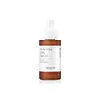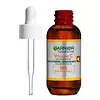What's inside
What's inside
 Key Ingredients
Key Ingredients

 Benefits
Benefits

 Concerns
Concerns

 Ingredients Side-by-side
Ingredients Side-by-side

Water
Skin ConditioningDipropylene Glycol
HumectantPropanediol
SolventAscorbic Acid 5.5%
Antioxidant2,3-Butanediol
HumectantGlycerin
HumectantPanthenol 2.7%
Skin ConditioningAlcohol Denat.
Antimicrobial3-O-Ethyl Ascorbic Acid 1.8%
Skin ConditioningGlycosyl Trehalose
Emulsion StabilisingBetaine
HumectantHydrogenated Starch Hydrolysate
HumectantFerulic Acid
AntimicrobialSorbitol
HumectantPolyglyceryl-10 Stearate
Skin ConditioningTromethamine
BufferingPolyglyceryl-10 Oleate
Skin ConditioningAllantoin
Skin ConditioningPhloretin
AntioxidantSodium Hyaluronate
HumectantCitrus Aurantifolia Oil
CleansingCitrus Aurantium Bergamia Fruit Oil
MaskingLavandula Angustifolia Oil
MaskingDextrin
AbsorbentDisodium EDTA
Serine
MaskingArginine
MaskingCarthamus Tinctorius Flower Extract
Skin ConditioningTheobroma Cacao Seed Extract
AntioxidantCitric Acid
BufferingAnthemis Nobilis Flower Oil
Masking1,2-Hexanediol
Skin ConditioningLimonene
PerfumingLinalool
PerfumingCitral
PerfumingWater, Dipropylene Glycol, Propanediol, Ascorbic Acid 5.5%, 2,3-Butanediol, Glycerin, Panthenol 2.7%, Alcohol Denat., 3-O-Ethyl Ascorbic Acid 1.8%, Glycosyl Trehalose, Betaine, Hydrogenated Starch Hydrolysate, Ferulic Acid, Sorbitol, Polyglyceryl-10 Stearate, Tromethamine, Polyglyceryl-10 Oleate, Allantoin, Phloretin, Sodium Hyaluronate, Citrus Aurantifolia Oil, Citrus Aurantium Bergamia Fruit Oil, Lavandula Angustifolia Oil, Dextrin, Disodium EDTA, Serine, Arginine, Carthamus Tinctorius Flower Extract, Theobroma Cacao Seed Extract, Citric Acid, Anthemis Nobilis Flower Oil, 1,2-Hexanediol, Limonene, Linalool, Citral
Water
Skin ConditioningAscorbic Acid
AntioxidantPentylene Glycol
Skin ConditioningGlycerin
HumectantSodium Hydroxide
BufferingHydroxyacetophenone
AntioxidantSalicylic Acid
MaskingCaprylyl Glycol
EmollientCaprylyl/Capryl Glucoside
CleansingPolyquaternium-67
Adenosine
Skin ConditioningTrisodium Ethylenediamine Disuccinate
Sodium Hyaluronate
HumectantLinalool
PerfumingLimonene
PerfumingGeraniol
PerfumingParfum
Masking
 Reviews
Reviews

Ingredients Explained
These ingredients are found in both products.
Ingredients higher up in an ingredient list are typically present in a larger amount.
Ascorbic Acid is is pure Vitamin C. This form makes up the largest amount of vitamin C found naturally in our skin.
Not only is vitamin C great for your overall health and immune system, it also has plenty of benefits on your skin.
Vitamin C is best used for brightening skin. It improves dark spots, acne scars, and hyperpigmentation. This is because it blocks the process of skin darkening when exposed to UV.
Remember: Vitamin C should not replace sunscreen!
Your skin uses vitamin C to build collagen. Collagen is one key component in having a strong skin barrier and plump skin. Vitamin C also plays a role in regulating collagen, thus making it effective in improving wrinkles and fine lines.
Ascorbic acid shows potent antioxidant activity. As an antioxidant, it helps fight free-radicals. Free-radicals are molecules that may damage your skin cells. These antioxidants also protect skin against UV damage.
The best formulations include Vitamin E and/or ferulic acid. These two ingredients help stabilize and provide a boost in the benefits of ascorbic acid. This is because ascorbic acid becomes unstable when exposed to UV and air. In fact, you can tell your ascorbic acid has oxidized when it turns an orange-yellow color.
Ascorbic acid is generally compatible with other ingredients. However, using ascorbic acid with other active ingredients might cause irritation. Two ingredients: copper ions and benzoyl peroxide, will inactivate ascorbic acid completely.
Read more about other types of Vitamin C:
Foods rich with vitamin C include oranges, strawberries, broccoli, bell peppers, and more. When consuming Vitamin C, your skin receives a portion of the nutrients.
Learn more about Ascorbic AcidGlycerin is already naturally found in your skin. It helps moisturize and protect your skin.
A study from 2016 found glycerin to be more effective as a humectant than AHAs and hyaluronic acid.
As a humectant, it helps the skin stay hydrated by pulling moisture to your skin. The low molecular weight of glycerin allows it to pull moisture into the deeper layers of your skin.
Hydrated skin improves your skin barrier; Your skin barrier helps protect against irritants and bacteria.
Glycerin has also been found to have antimicrobial and antiviral properties. Due to these properties, glycerin is often used in wound and burn treatments.
In cosmetics, glycerin is usually derived from plants such as soybean or palm. However, it can also be sourced from animals, such as tallow or animal fat.
This ingredient is organic, colorless, odorless, and non-toxic.
Glycerin is the name for this ingredient in American English. British English uses Glycerol/Glycerine.
Learn more about GlycerinLimonene is a fragrance that adds scent and taste to a formulation.
It's found in the peel oil of citrus fruits and other plants such as lavender and eucalyptus. The scent of limonene is generally described as "sweet citrus".
Limonene acts as an antioxidant, meaning it helps neutralize free radicals.
When exposed to air, oxidized limonene may sensitize the skin. Because of this, limonene is often avoided by people with sensitive skin.
The term 'fragrance' is not regulated in many countries. In many cases, it is up to the brand to define this term. For instance, many brands choose to label themselves as "fragrance-free" because they are not using synthetic fragrances. However, their products may still contain ingredients such as essential oils that are considered a fragrance.
Learn more about LimoneneLinalool is a fragrance and helps add scent to products. It's derived from common plants such as cinnamon, mint, citrus, and lavender.
Like Limonene, this ingredient oxidizes when exposed to air. Oxidized linalool can cause allergies and skin sensitivity.
This ingredient has a scent that is floral, spicy tropical, and citrus-like.
Learn more about LinaloolSodium Hyaluronate is hyaluronic acid's salt form. It is commonly derived from the sodium salt of hyaluronic acid.
Like hyaluronic acid, it is great at holding water and acts as a humectant. This makes it a great skin hydrating ingredient.
Sodium Hyaluronate is naturally occurring in our bodies and is mostly found in eye fluid and joints.
These are some other common types of Hyaluronic Acid:
Learn more about Sodium HyaluronateWater. It's the most common cosmetic ingredient of all. You'll usually see it at the top of ingredient lists, meaning that it makes up the largest part of the product.
So why is it so popular? Water most often acts as a solvent - this means that it helps dissolve other ingredients into the formulation.
You'll also recognize water as that liquid we all need to stay alive. If you see this, drink a glass of water. Stay hydrated!
Learn more about Water